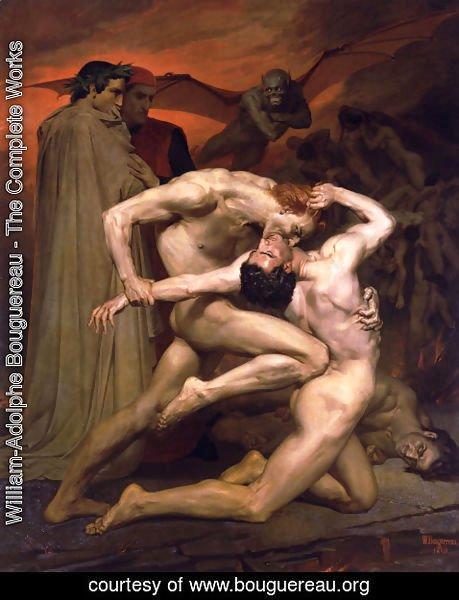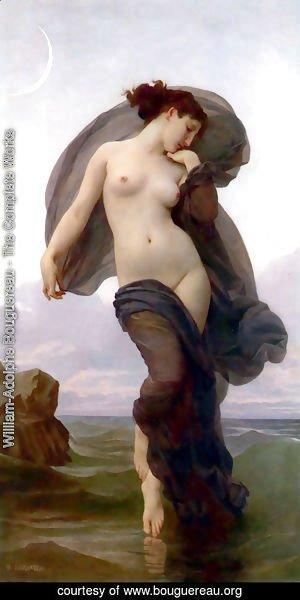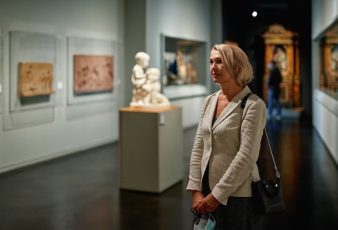William-Adolphe Bouguereau was one of the most important representatives of French painting. The main topics of his work were mythological, allegorical, and biblical subjects, as well as portrait painting. He preferred to paint his canvas from nature and professional models posed for him. He managed to reproduce them with photographic accuracy. His style can be called romantic realism art. He was a member of the Academy of Fine Arts, Julian Academy, and professor at the French National Higher School of Fine Arts. This gave him rigorous academic hardening and he stood firm on the traditions and art techniques of conservative Salons. With Impressionism becoming more popular, Bouguereau intensified his confrontation by involving administrative resources. This led his work to be criticized, and after the life of the academician, all art literature was full of condemnation of his work. Nevertheless, after almost a century, the attitude to salon-academic art has changed. So, the critics again began to consider Bouguereau as one of the most influential painters of the 19th century. It’s worth taking a look at his work at bouguereau.org and make your own conclusion about the work of William-Adolphe Bouguereau and his realism art.
Religious theme
Dante and Virgil in hell
Bouguereau created many paintings on religious and mythological themes. A significant number of paintings were written based on the works of Dante. Dante and Virgil in Hell is a bewitching but at the same time gloomy illustration of the plot of the Divine Comedy.
The moment on the canvas reveals the path of Dante accompanied by his teacher Virgil in the third circle of hell. In eternal torment blasphemers and rapists suffer. In the foreground, two naked male figures are so beautiful that it’s hard to believe they have so much vice. Bouguereau portrayed these men and their emotions in dynamics, wonderfully embodying anatomical accuracy. The travelers Dante and Virgil themselves are outside observers here. They are almost hidden behind the scene of violence, their figures and emotions are less pronounced.
Allegorical works
La Crepuscule
In the early 1880s, Bouguereau created a series of paintings – Dawn, Evening Mood, Dawn, Day, and Night. It was devoted to the times of the day, in which he achieved a harmonious combination of sensuality and lyricism. They became the author’s transition to a topic that was completely devoid of mythological meaning or allegorical motives.
Nude genre
In 1884, such works as Seated Nude and Bathers were written in a style of nude. In these paintings, Bouguereau expresses the charm of the female body in itself. Some critics express the view that the figures of these models should have been a visual tutorial in teaching students. In one of his lectures, Bouguereau stated that traditional art contained many elements allowing us to have endless inspiration. Saying this, he had in mind the image of the human anatomy – arms, torso, busts, heads. Only this can be enough for subjects of painting and sculpture.
The Return of Spring
In 1886, the painting The Return of Spring caused heated discussions in the Salon. The theme of the picture is the origin of love. But many saw in this work the immorality of the author. Four years later, this painting became the property of a gallery in Omaha, USA. One of the visitors even made an attempt to destroy this picture, as he told, to protect female dignity. The British writer and historian Kenneth Clark described the nude portraits as a repudiation of reality and even voluptuousness. Despite this, the artist himself was proud of The Return of Spring and continued to actively use the themes inherent in this painting and beyond.
The soul in the paintings
Bouguereau wanted to reveal that equality and dignity are noble features. He depicted innocent young girls with solemn generosity and gracious beauty. They were shy and docile, melancholy, and humbled. Also, the could be bold and confident as his shepherdess holding a staff and standing still.
Bouguereau was in a constant search to find the inner soul of his subject. Each of his figures is individual, remarkably real, and excellent at the same time. His paintings show a tendency of familiarization with the person, his soul, diverse moods, and moments in life.
He loved to draw his own world, which he called his “fantasies”, filled with beautiful nymphs, playful cupids, and an occasional satyr. The freedom to paint such things could be considered insanity or heresy a few short decades earlier. His work was so in demand that the subject of each canvas was his personal choice.
Read Also:

































